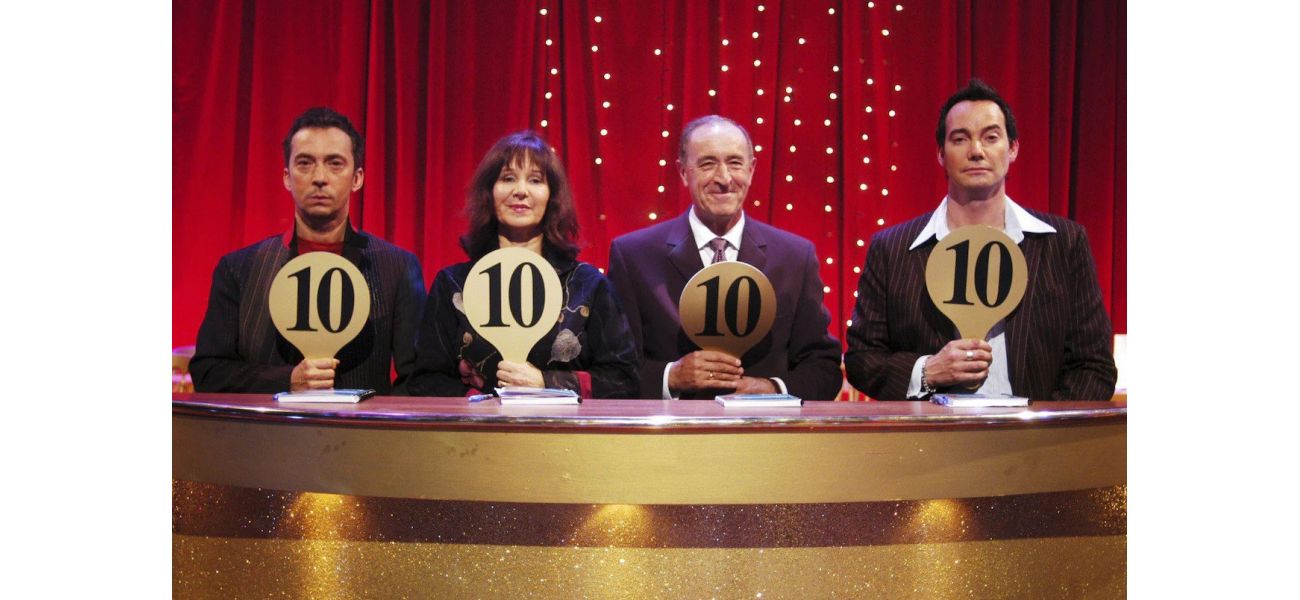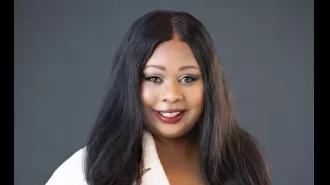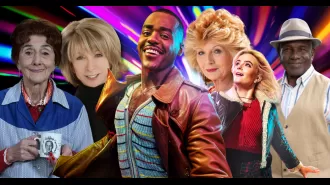I didn't expect Strictly Come Dancing to succeed, but one event completely transformed its fate.
Hear from Dame Arlene Phillips, Brendan Cole, and Jane Lush about the inaugural season.
September 11th 2024.

When Strictly Come Dancing first premiered in 2004, no one could have predicted the massive success it would become. It was just a simple two-month competition between eight celebrities, intended to fill a Saturday night slot for the BBC. But as the show quickly gained popularity, it became clear that it was going to be much bigger than anyone could have imagined.
Today, Strictly is one of the most successful reality TV formats in the world, with versions in over 75 countries, including the USA, China, and Brazil. In the UK, it has become a beloved part of our culture, with viewers tuning in every weekend to watch hosts Tess Daly and Claudia Winkleman guide famous faces through their dance routines.
But how did it all begin? We spoke to three key figures who played pivotal roles in the show's early days: Dame Arlene Phillips, Brendan Cole, and Jane Lush. These three individuals were instrumental in shaping the first season of Strictly and setting it on the path to success.
Jane Lush, former Head of Entertainment and Comedy at the BBC, was the driving force behind the show's creation. She wanted to create a program that would appeal to people who chose to stay in on Saturday nights, rather than going out. She described it as a "great night in" and envisioned a show that would combine celebrities with professional dancers and judges holding paddles with numbers on them.
But not everyone was convinced that this was a good idea. Some of Jane's colleagues thought she was crazy for trying to bring back Ballroom dancing on a Saturday night, especially since the show's predecessor, Come Dancing, had been deemed a failure and taken off the air. However, Jane was determined to make it work and convinced the BBC Controller, Lorraine Heggessey, to give the show a chance.
The show was initially called Strictly Come Dancing, after Baz Luhrmann's film Strictly Ballroom. However, BBC executives didn't want the word "celebrity" in the title, as it hadn't been successful in other programs. So, the name was changed to just Strictly Come Dancing, and the rest is history.
The first season of Strictly featured hosts Tess Daly and the late Sir Bruce Forsyth, whom Jane met at an "obscure Italian restaurant" to pitch the show. Sir Bruce loved the idea and thought it was fantastic, and he went on to host the show from 2004 until 2013.
The show's original judging panel consisted of Len Goodman, Arlene Phillips, Bruno Tonioli, and Craig Revel Horwood. However, during the audition process, they couldn't decide on just three judges, so they ended up with four. This caused a bit of a problem, as the desk they sat at was too small for all of them, and they had to squeeze in.
The first batch of celebrities included Claire Sweeney and David Dickinson, but it was Natasha, who was a major part of the show's vision, who ended up winning. Jane had wanted to recreate the "magical TV moment" when journalist Angela Rippon danced with Morecambe and Wise on TV. However, Natasha was hesitant to participate, as she was worried that being on Strictly would diminish her status as a newsreader. But she ended up being a fantastic dancer and won the competition.
Arlene Phillips, one of the original judges, was initially skeptical about the show's potential for success. She didn't even want to audition, as she wasn't interested in TV work. But after some convincing, she found herself in a dance studio, judging dancers alongside Len Goodman. During the audition process, Len was getting grumpy because he was worried about being late for dinner with his wife, Sue.
Despite the doubters and the difficulties, the first episode of Strictly was a huge success, and the show continued to gain popularity throughout its first season. The BBC even aired a second season that same year, as they didn't have anything else that could compete with it, like ITV's The X Factor.
Looking back, it's clear that Jane's brainstorming meeting and the hard work of everyone involved truly changed television forever. Strictly Come Dancing has become an integral part of British culture, and its core values of competitive dancers, celebrities on a journey, and viewer participation are still evident 20 years later.
When Strictly Come Dancing first aired in 2004, no one could have predicted the massive success it would become. The show, which was originally envisioned as a simple two-month competition between eight celebrities, quickly became a sensation that captured the hearts of audiences all over the world. Now, as we celebrate its 20th anniversary, it's clear that Strictly has become much more than just a Saturday night TV slot for the BBC.
In fact, the show has become a global phenomenon, with versions in over 75 countries, including the USA, China, and Brazil. But it's in the UK where Strictly has truly become a cultural staple. Spending cold winter weekends watching hosts Tess Daly and Claudia Winkleman cheer on our favorite celebrities as they compete on the Bafta-winning show has become a beloved tradition for many. But how did it all begin?
To find out, The Agency spoke to three key figures who played pivotal roles in the show's inception: Dame Arlene Phillips, Brendan Cole, and Jane Lush. According to Jane, who was the former Head of Entertainment and Comedy at the BBC at the time, the idea for Strictly came about during a brainstorming session. She and her team wanted to create a show that would appeal to people who chose to stay in on Saturday nights, rather than go out. They wanted to provide audiences with a great night in, and that's exactly what they did.
One of the ideas that was thrown around during the meeting was a celebrity version of the old show Come Dancing, which pitted amateur ballroom dancers against each other. But Jane had a vision for something more. She suggested doing a Pro Celebrity Dancing show, where professional dancers would teach celebrities, and judges would hold up paddles with numbers on them. And just like that, Strictly Come Dancing was born.
However, not everyone was convinced that the show would be a success. Many thought that reviving an old-fashioned show like Come Dancing was a crazy idea. But Jane and her team were determined to make it work, and they eventually convinced the Controller of BBC, Lorraine Heggessey, with the help of a dancer who wowed them with their moves during the pitch meeting. And thus, the show got the green light.
But it wasn't all smooth sailing. Initially, the show was going to be called Pro Celebrity Dancing, but BBC bosses didn't want to use the word "celebrity" in the title, as it hadn't proven successful in the past. So they settled on Strictly Come Dancing, as a nod to the film Strictly Ballroom. And although they briefly considered calling it Come Dance with Me, they didn't want it to sound too similar to the Channel 4 show Come Dine with Me.
The first series of Strictly Come Dancing premiered in 2004, with hosts Tess Daly and the late Sir Bruce Forsyth at the helm. The show was an instant hit, with viewers loving the core values of the competition – the set design, the voting method, the competitive dancers, and the celebrities on a journey. And even though they had some initial setbacks, like the judges having to squeeze into a too-small desk, the show was a success from the very first episode.
One of the contestants on that first season was journalist Natasha Kaplinsky, who ended up winning the competition. According to Jane, Natasha was hesitant to participate, as she was worried that it would diminish her status as a newsreader. But Jane was determined to recreate the "magical TV moment" of journalist Angela Rippon dancing on Morecambe and Wise, and she eventually convinced Natasha to take part. And the rest, as they say, is history.
For original judge Arlene Phillips, the success of Strictly Come Dancing was hard to predict. In fact, she initially had no interest in taking part in the show at all. As an 80-year-old choreographer, she wasn't looking for TV work. But after some persuasion, she found herself in a dance studio in Notting Hill, judging dancers alongside Len Goodman, who was becoming increasingly grumpy as he worried about being late for dinner with his wife.
Despite the initial doubts, Strictly Come Dancing has become a cultural phenomenon that shows no signs of slowing down. And as we celebrate its 20th anniversary, it's clear that the show has become much more than just a simple two-month competition. It's a beloved tradition that brings together people of all ages and backgrounds, and we can't wait to see what the next 20 years will bring for Strictly Come Dancing.
Today, Strictly is one of the most successful reality TV formats in the world, with versions in over 75 countries, including the USA, China, and Brazil. In the UK, it has become a beloved part of our culture, with viewers tuning in every weekend to watch hosts Tess Daly and Claudia Winkleman guide famous faces through their dance routines.
But how did it all begin? We spoke to three key figures who played pivotal roles in the show's early days: Dame Arlene Phillips, Brendan Cole, and Jane Lush. These three individuals were instrumental in shaping the first season of Strictly and setting it on the path to success.
Jane Lush, former Head of Entertainment and Comedy at the BBC, was the driving force behind the show's creation. She wanted to create a program that would appeal to people who chose to stay in on Saturday nights, rather than going out. She described it as a "great night in" and envisioned a show that would combine celebrities with professional dancers and judges holding paddles with numbers on them.
But not everyone was convinced that this was a good idea. Some of Jane's colleagues thought she was crazy for trying to bring back Ballroom dancing on a Saturday night, especially since the show's predecessor, Come Dancing, had been deemed a failure and taken off the air. However, Jane was determined to make it work and convinced the BBC Controller, Lorraine Heggessey, to give the show a chance.
The show was initially called Strictly Come Dancing, after Baz Luhrmann's film Strictly Ballroom. However, BBC executives didn't want the word "celebrity" in the title, as it hadn't been successful in other programs. So, the name was changed to just Strictly Come Dancing, and the rest is history.
The first season of Strictly featured hosts Tess Daly and the late Sir Bruce Forsyth, whom Jane met at an "obscure Italian restaurant" to pitch the show. Sir Bruce loved the idea and thought it was fantastic, and he went on to host the show from 2004 until 2013.
The show's original judging panel consisted of Len Goodman, Arlene Phillips, Bruno Tonioli, and Craig Revel Horwood. However, during the audition process, they couldn't decide on just three judges, so they ended up with four. This caused a bit of a problem, as the desk they sat at was too small for all of them, and they had to squeeze in.
The first batch of celebrities included Claire Sweeney and David Dickinson, but it was Natasha, who was a major part of the show's vision, who ended up winning. Jane had wanted to recreate the "magical TV moment" when journalist Angela Rippon danced with Morecambe and Wise on TV. However, Natasha was hesitant to participate, as she was worried that being on Strictly would diminish her status as a newsreader. But she ended up being a fantastic dancer and won the competition.
Arlene Phillips, one of the original judges, was initially skeptical about the show's potential for success. She didn't even want to audition, as she wasn't interested in TV work. But after some convincing, she found herself in a dance studio, judging dancers alongside Len Goodman. During the audition process, Len was getting grumpy because he was worried about being late for dinner with his wife, Sue.
Despite the doubters and the difficulties, the first episode of Strictly was a huge success, and the show continued to gain popularity throughout its first season. The BBC even aired a second season that same year, as they didn't have anything else that could compete with it, like ITV's The X Factor.
Looking back, it's clear that Jane's brainstorming meeting and the hard work of everyone involved truly changed television forever. Strictly Come Dancing has become an integral part of British culture, and its core values of competitive dancers, celebrities on a journey, and viewer participation are still evident 20 years later.
When Strictly Come Dancing first aired in 2004, no one could have predicted the massive success it would become. The show, which was originally envisioned as a simple two-month competition between eight celebrities, quickly became a sensation that captured the hearts of audiences all over the world. Now, as we celebrate its 20th anniversary, it's clear that Strictly has become much more than just a Saturday night TV slot for the BBC.
In fact, the show has become a global phenomenon, with versions in over 75 countries, including the USA, China, and Brazil. But it's in the UK where Strictly has truly become a cultural staple. Spending cold winter weekends watching hosts Tess Daly and Claudia Winkleman cheer on our favorite celebrities as they compete on the Bafta-winning show has become a beloved tradition for many. But how did it all begin?
To find out, The Agency spoke to three key figures who played pivotal roles in the show's inception: Dame Arlene Phillips, Brendan Cole, and Jane Lush. According to Jane, who was the former Head of Entertainment and Comedy at the BBC at the time, the idea for Strictly came about during a brainstorming session. She and her team wanted to create a show that would appeal to people who chose to stay in on Saturday nights, rather than go out. They wanted to provide audiences with a great night in, and that's exactly what they did.
One of the ideas that was thrown around during the meeting was a celebrity version of the old show Come Dancing, which pitted amateur ballroom dancers against each other. But Jane had a vision for something more. She suggested doing a Pro Celebrity Dancing show, where professional dancers would teach celebrities, and judges would hold up paddles with numbers on them. And just like that, Strictly Come Dancing was born.
However, not everyone was convinced that the show would be a success. Many thought that reviving an old-fashioned show like Come Dancing was a crazy idea. But Jane and her team were determined to make it work, and they eventually convinced the Controller of BBC, Lorraine Heggessey, with the help of a dancer who wowed them with their moves during the pitch meeting. And thus, the show got the green light.
But it wasn't all smooth sailing. Initially, the show was going to be called Pro Celebrity Dancing, but BBC bosses didn't want to use the word "celebrity" in the title, as it hadn't proven successful in the past. So they settled on Strictly Come Dancing, as a nod to the film Strictly Ballroom. And although they briefly considered calling it Come Dance with Me, they didn't want it to sound too similar to the Channel 4 show Come Dine with Me.
The first series of Strictly Come Dancing premiered in 2004, with hosts Tess Daly and the late Sir Bruce Forsyth at the helm. The show was an instant hit, with viewers loving the core values of the competition – the set design, the voting method, the competitive dancers, and the celebrities on a journey. And even though they had some initial setbacks, like the judges having to squeeze into a too-small desk, the show was a success from the very first episode.
One of the contestants on that first season was journalist Natasha Kaplinsky, who ended up winning the competition. According to Jane, Natasha was hesitant to participate, as she was worried that it would diminish her status as a newsreader. But Jane was determined to recreate the "magical TV moment" of journalist Angela Rippon dancing on Morecambe and Wise, and she eventually convinced Natasha to take part. And the rest, as they say, is history.
For original judge Arlene Phillips, the success of Strictly Come Dancing was hard to predict. In fact, she initially had no interest in taking part in the show at all. As an 80-year-old choreographer, she wasn't looking for TV work. But after some persuasion, she found herself in a dance studio in Notting Hill, judging dancers alongside Len Goodman, who was becoming increasingly grumpy as he worried about being late for dinner with his wife.
Despite the initial doubts, Strictly Come Dancing has become a cultural phenomenon that shows no signs of slowing down. And as we celebrate its 20th anniversary, it's clear that the show has become much more than just a simple two-month competition. It's a beloved tradition that brings together people of all ages and backgrounds, and we can't wait to see what the next 20 years will bring for Strictly Come Dancing.
[This article has been trending online recently and has been generated with AI. Your feed is customized.]
[Generative AI is experimental.]
0
0
Submit Comment





